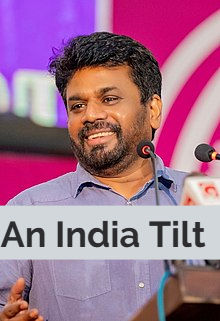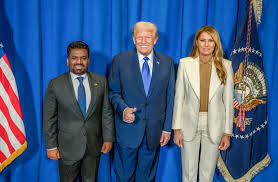Review: Sri Lanka’s Political Crisis, What Lies Ahead?
- Security Risks Research
- Aug 26, 2022
- 7 min read

In the beginning of the Year 2022, the Rajapaksa brothers – Gotabaya as the President and Mahinda as the Prime Minister with Basil managing political affairs of the Sri Lanka Podujana Peramuna (SLPP) which had a majority in the parliament were strongly perched in power in Colombo but there were ominous signs of vulnerability.
Not surprisingly, President Gotabaya Rajapaksa delivering government’s policy statement on January 18th in the Parliament called on Government and Opposition parties to unite.
The message for unity was in order as given multiple challenges faced by the country from foreign exchange to food and energy security.
However, many saw the government agenda as divisive thus creating more ethnic and religious discord which was not conducive to unity.
There was no hope for unity under the Rajapaksa’s and as the economic hardship grew, public remonstrations commenced which snowballed into a massive bulge, the “Aragalaya,” protests that called for, Gota Go Gama or Gotabaya to resign.
These finally brought down the Rajapaksa brothers but not in the manner that was expected both within and outside the country.
By the middle of the year the “family,” hold was shaky with Mahinda Rajapaksa having to resign amidst controversy on May 9 as his supporters ran amuck to attack protestors at Galle Face. It was a version of Sri Lanka’s Arab Spring, but the exit of President Gotabaya was the most ignominious having to leave hastily commandeering a Sri Lanka Air Force plane his last order as the chief executive of the country to neighbouring Maldives. Here is a review of how the crisis developed and what lies ahead.
Political Crisis Unfolds
The Rajapaksa’s – President Gotabaya and PM Mahinda were clearly fighting a losing battle to retain their hold on power after public protests demanding their removal gathered momentum.
The President and PM played political hopscotch to form an “all-party government” (APG) as though it was a panacea for the national crisis.
Public unpopularity of the Rajapaksa’s meant that the attempt to form an all-party government was a nonstarter.
More time seems to have been generated on pulling the rug under the feet of the elder Rajapaksa to remove him as PM, while some others wanted both out.
The driving force was public protests at Galle Face demanding resignation of the President and the government. Multiple organisations backed the protestors who continued amidst the heat and rains.
A fateful move by supporters of Prime Minister Mahinda Rajapaksa on May 09, to attack the protestors at Galle Face led to his downfall.
The formally elected prime minister Mahinda Rajapaksa resigned after hundreds of his supporters violently attacked peaceful protesters stationed outside his official residence and at the main “Gota Go Gama” protest camp in the capital Colombo on May 09. The details of the incidents are murky which included torching of personal residence of the Prime Minister.
Ranil Replaces Mahinda
Ranil Wickremesinghe replaced Mahinda Rajapaksa as prime minister in the following month of May. The installed PM had neither proven parliamentary majority nor constitutional authority.
Sri Lanka’s Parliament’s action to elect Ranil Wickremesinghe as new President of the country in the wake of President Rajapaksa’s resignation was essential to avoid a power vacuum in the country.
For Sri Lankans hankering for political change however this is merely reinforcement of the status quo and thus has come as a disappointment.
Meanwhile, the leader of the Opposition and Samagi Jana Balawegaya (SJB) Leader Sajith Premadasa said the next parliamentary session would be crucial and that the no-confidence motion against the government will be brought in as a strength to the people’s struggle.
However, the President’s ploy of bringing in Ranil as Prime Minister confused the opposition which was vociferously demanding Gotabaya’s resignation.
It also split the ranks of the main opposition SJB, after Ranil said his acceptance of office was conditional on replacing the 20th Amendment to the constitution that concentrated all powers in the hands of the executive president which was one of the demands of the Party.
Sri Lanka Freedom Party (SLFP) led by former president Sirisena, after some posturing on the sidelines, supported PM Wickremesinghe and the all-party government.
The other parties, barring the weakened SJB and the Janatha Vimukthi Peramuna (JVP), which had questioned the constitutionality of installing Ranil as PM, finally had to relent.
As the Prime Minister Ranil Wickremesinghe only bought time for President Gotabaya Rajapaksa to weather the mounting mass protests demanding resignation of Rajapaksa’s from power.
PM Wickremesinghe’s regular public communications to prepare the people to face the difficult times ahead probably helped the administration to manage public protests despite continued aberrations in governance.
For the common man high inflation and cost of living, shortages, rationing of fuel, queues and attended nepotism, power cuts, restricted functioning of public offices and schools, cronyism, bribery, and corruption continued,
In a tipping point, protestors rushed in and occupied the Presidential Palace. The “Sri Lankan Spring,” was complete and on July 09, fearing public outrage, President Rajapaksa fled to the Maldives and then to Singapore.
Ironically, the continuing “Aragalaya” protests paved the way for PM Wickremesinghe to be elected president by most parliamentarians as in the Sri Lankan system.

Ranil as President
Sri Lanka’s Parliament’s action to elect Ranil Wickremesinghe as new President of the country in the wake of President Rajapaksa’s resignation was essential to avoid a power vacuum in the country.
In a secret ballot held on July 20, he secured 134 votes, with a comfortable margin of 52 votes over his nearest rival Dallas Alahapperama of Sri Lanka Podujana Peramuna (SLPP). Wickremesinghe’s victory is a demonstration of the influence wielded by the Rajapaksa’s in the present parliament, despite their absence.
For Sri Lankans hankering for political change however this was merely reinforcement of the status quo and thus has come as a disappointment. The protesters announced that their agitation will continue, a move that risks more unrest as Wickremesinghe has signaled a willingness to use force to maintain public order and may be looking at the crisis from a securitization perspective without addressing real needs of the masses.
This would explain President Wickremesinghe’s rather heavy-handed crackdown on protestors using the army and the STF, to clear the President’s House and Secretariat occupied by them.
The authorities also arrested Pathum Kerner, one the founders of the ‘GotaGoGama protests and issued a look out notice for other leaders of the Aragalaya. They searched several church premises to arrest Fr Amila Jeewantha Peiris, a Catholic priest and activist.
Arrest warrants were issued to nab activists Lahiru Weerasekara and Venerable Tamipitiye Sugathananda when they failed to appear before the court to answer charges of unlawful assembly. Inter University Student Federation (IUSF) convenor Wasantha Mudalige, who is one of the brains behind the Aragalaya was served with a no foreign flight order blog of DBS Jeyaraj.
President Wickremesinghe brought in the SLPP’s former leader of the House and long-time parliamentarian Dinesh Gunawardena as PM. His 21-member cabinet is largely composed of those who had served in the Rajapaksa government.
As per noted columnist and observer of the Sri Lankan situation Col R Hariharan, this has drawn derisive comments of old wine in old bottle, with a new Wickremesinghe label. President Wickremesinghe and PM Gunawardena have started their rule with the inherited burden that brought down President Rajapaksa’s rule.
Mr. Wickremesinghe has been able to gain support from the Buddhist clergy and has installed a cabinet that is favourable towards his instructions and the naysayers have been eliminated.
But economic challenges facing Sri Lanka are immense. Sri Lanka’s inflation, as measured by the change in the Colombo Consumers’ Price Index (CCPI) increased to 60.8 percent in July 2022 from 54.6 percent in June 2022. Economic relief to the people alone will wave Wickremesinghe
What Lies Ahead?
The year 2022 was marked by sustained political instability with initially opposition lacking the numbers to depose the government and the Rajapaksa brothers digging in.
Even with a dramatic turn of events, with a new Prime Minister and President, political flux continues along with fuel and food concerns.
The economy struggles to stay afloat. A semblance of political stability has returned but the situation continues to remain volatile requiring a close watch.
A President was sworn in as a National List MP of the United National Party (UNP) as the Party could not even have one elected member after split by the SJB.
But to the credit of Mr. Ranil he opted for the hot seat that none was willing to accept at a time of acute financial crisis which led to outpourings on the streets.
The SJB has assured issue-based support to the President but will not join the government. However SJB leader possibly suspects that the President wants to rebuild the UNP. The Leader of Janatha Vimukthi Peramuna (JVP) and National People’s Power (NPP) MP Anura Kumara Dissanayake have called on the people of the country to come forward to oust the current government. These parties had contributed the political muscle to the protests.
Over that there are reports that former president Gotabaya Rajapaksa, who fled the country last month amid public protest, may return home in September. He is presently in Thailand. If that happens protesting parties and organisations are expected to get a boost.
On the economic front discussions between representatives of the International Monetary Fund and Sri Lankan government authorities commenced on August 24 at the Central Bank premises in Colombo.
As per the Colombo Page objective is to make progress towards reaching a staff-level agreement on a prospective IMF Extended Fund Facility (EFF) arrangement in the near term.
Because Sri Lanka’s public debt is assessed as unsustainable, approval by the IMF Executive Board of the EFF program would require adequate assurances by Sri Lanka’s creditors that debt sustainability will be restored, the IMF said.
This is likely to be a very tough proposition as the debt is huge and is spread over multiple channels.
At one time President Wickremesinghe had highlighted dimensions of the debt thus, “In the economic crisis we are facing, the huge problem is the national debt. According to government statistics on public debt, the percentage of debt received from China is 10%. 13% from the Asian Development Bank, 9% from the World Bank, and 47% from sovereign bonds (ISB). 10% from Japan, 2% from India and 9% from all other countries.” Bringing all these lenders on the same slate will remain a challenge.
Much will depend on the agriculture harvest, energy imports with Russia being an option and related geopolitical issues, balancing support by India and China evident in the recent Yuan Wang 5 PLA’s tracking ship incident. Thus the Island nation continues to be surrounded by choppy waters ahead.
[Note the Review is based on monthly perspectives of Col R Hariharan]
[Compilation and editorial support by Harshita Panwar are acknowledged]



Comments